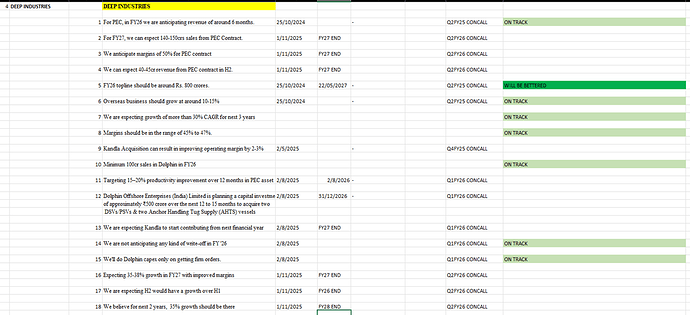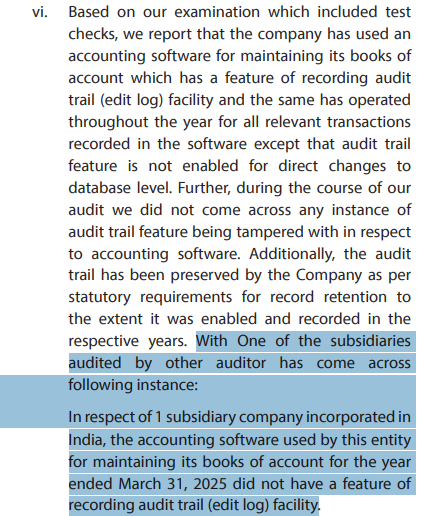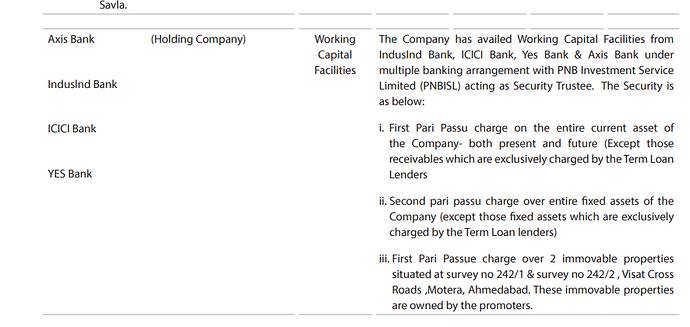Long post ahead
(Page 179 of AR 2024-25, Deep Industries Ltd.)
A charge is a lien created against the company’s assets for a loan. So if you take a secured loan, the company has to register a charge on behalf of the loan provider so that in event of default, the loan provider can claim the proceeds from the sale of the said asset. So a charge of Re. 1 means the loan amount is either equal to or less than Re.1
All Working capital loans taken by Deep Industries are hypothecated against its Current Assets (65% of which are trade receivables). In fact, even some term loans (with maturity of more than one year) are secured against trade receivables.
Concept of Margin Requirement and why is it relevant
Suppose my Current Assets are Rs. 100 crores. If the bank gives a 25% margin, I will get a loan of Rs. 75 crores. If ay any point my Current Asset value falls below Rs. 75 crores, say 70 crores, I will have to deposit Rs. 5 crores (75-5) with the bank. This is also known as Margin Call.
Conversely, I can avail more loan if my Current Assets increase.
Deep Industries Ltd.
DIL Index of Charges.XLSX (19.5 KB) Source: Ministry of Corporate Affairs
Please refer to the excel above containing all charges yet to be satisfied. (Satisfaction of charge occurs when either the loan is repaid or asset is removed from the charge).
Row 22; Charge Holder PNB Investment Services Ltd. ; Date of Creation 23/01/2023
As depicted in the first pic of the post, PNB Investment Services is the Security Trustee for charges against the company’s Current Assets. The amount of charge is a whopping Rs. 237. 50 crores.
Interestingly, this charge was created (loan taken against current assets) only weeks after the acquisition of Dolphin, where around 150 crores of receivables (Current Assets) were added in the balance sheet of Deep Industries. The receivables, which by the way are outstanding from a very long time and for whom no provision has been made yet. (A provision would reduce the trade receivable balance and hence reduce the amount of total current assets, which could trigger a margin call)
Similarly, just months after the acquisition of Kandla Energy, another charge was created on 8/09/2025 (refer row 2 of the excel) in favour of Axis Bank Ltd. Axis bank has too provided Working capital Loans to the company.
Notice a pattern? Acquire companies cheaply, with high receivables. Keep the receivables in the consol books. Do not make a provision (which would reduce current assets). Ask the auditors to not verify those receivables. Take working capital loans against those receivables. Acquire companies cheaply.
There is a clear benefit to the management by not writing off receivables. If it did, its working capital sanctions would get affected, drastically. Imagine the impact of a 300 crore write off in the current assets on the outstanding working capital loan limit.
Furthermore, the current borrowings, excluding current maturities of long term debt has almost increased by 8 times as at 31.03.2025 when compared to 31.03.2024! I would not be surprised if this figure increases further.
I once asked a question on the Kandla acquisition, Why now? I have gotten my answer. Free onboarding of 200 crores of receivables which will enable them to take loans against them faster. In fact this could also be the reason why management is not letting the auditors verify those balances. Kandla also did not have a audit trail per se. So there are no internal controls, external verification or other confirmation regarding these balances against whom such gigantic loans are taken. They needed to take a WC loan faster and hence hurried on the Kandla acquisition to increase their book value of current assets.
This in my humble opinion establishes a clear motive for the management to not take provisions for receivables.
Regarding Inventories
Inventories are also current assets. The management in fact did take an inventory write down as an exceptional item in FY 2025. Here is my theory (the below two paragraphs should not be construed as a statement of fact):
As per regulatory requirements, stock audits should be carried out for all WC limits in excess of Rs. 5 crores. Stock audits are also required to be certified by a practicing Chartered Accountant and the margin requirement for stocks is much less than that of Debtors. (For example, for stock worth 100 crores you will get a loan of 85 crores as against a loan of 60 crores for a 100 crores worth of debtors)
Now when the stock auditors conducted the stock audit, they realised that the stock acquired from these acquisitions are not realisable and hence made them (the management) write down its inventory. There is no such requirement for debtors, lol. The management in fact admitted in an earnings call that these inventories were not realisable.
Some tough questions for the management in the next earnings call in addition to the usual 60% growth guidance ones:
- Are the receivables of Kandla hypothecated for the working capital loans? If yes, will the reduction in these receivables affect the working capital sanction limit?
- Was the inventory that the management wrote off in Q4 FY 2024-25, written off after the stock audit was conducted? Were they hypothecated in the first place?
- Will working capital sanction limit increase if the company acquires yet another company, adding up on its receivables?
The Game, Mrs. Hudson, is ON.




